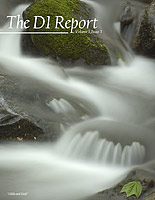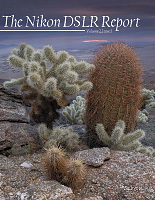Thom Hogan's Nikon DSLR Report
The Nikon DSLR Report (formerly The D1 Report) has a price of $69.95. For that you'll get four issues on CD-ROM in Adobe PDF form. Each issue tends to be 30 full-sized pages or more. As the name suggests, the quarterly reports include information relevant to the Nikon D1, D1h, D1x, D100, the Fujifilm S2 Pro, and the Kodak DCS Pro 14n. Each issue starts with a full 8x10 300 dpi cover taken with a D1x or other digital SLR. If you don't think the digital SLRs are capable of high-quality images, the covers alone should convince you otherwise.
 "Expose for the Highlights..."
"Expose for the Highlights..."
The first issue (Dec 01) contained articles on:
- D1 Autofocus Sensor Placement. A worst case test of the placement of the autofocus sensors in the D1 models (true of D100 and S2 sensors, too). Since Nikon used the exact same mechanism as is in the 35mm bodies, does the smaller CCD size make a difference? The answer, in a word: yes.
- Bibble, Capture, or QImage? Every NEF user asks the same question: which product to use. There are differences in speed, integration, and quality between the products. To pick the right one for you, you need to evaluate those differences.
- Recognizing Image Artifacts. How to recognize chromatic aberration, coma, blooming, aliasing, moire, JPEG artifacts, long exposure freckles, diffraction, barrel and pincushion distortion, and imaging noise. Since each requires a slightly different tactic to remove or minimize, you'd better know which one you're dealing with!
- Higher ISO or Slower Shutter Speed? Avoiding noise is one ingredient to creating higher quality digital photos. So, when pressed with the choice of increasing the ISO value or lengthening the shutter speed, which should you do? This article gives you the information you need.
- Plus much more... Clean CCD rules, when to shift from Auto white balance, 7 habits of effective digital SLR users, Web sites of interest to D1 users.
 "Color
is What You Make It..."
"Color
is What You Make It..."
The second issue (Feb 02) contained articles on:
- White Balance. An extended discussion of what became a shorter, more succinct section in the latest update of the Complete Guide to the D1h, D1h, & D1x.
- Getting Flash Right. An extended discussion of my usual 4-part advice on setting camera and flash.
- Color Management.This extended article takes up most of the issue, and includes sub-topics such as: What is Color?, Your Monitor has a Temperature, Color Gamuts, Camera Profiles, Working Space, The Color Management Chain, Printing, Color Mode, CIE and Color.
 "Odds and Ends..."
"Odds and Ends..."
The third issue (Sept 02) contained articles on:
- Macro TTL . A do-at-your-own-risk alternative to the SB-29. Basically, you hack up an SB-50DX and a low-cost ringflash, such as those provided by Sunpack.
- More Flash Info. More detailed information about what happens when you press the shutter release with a flash attached. This information is then used to describe how wireless flash does (or doesn't work) on the D100 and D1 bodies. Rediscover why the SB-26 was the best wireless flash Nikon made, at least for us D-TTL hostages.
- Hardware Goodies. Flapcatch, Hoodman, Cokin P, Speckgrabber, Flexhoods, Warmcards, Ickiewarez raincovers, fish-eye lens attachments, infrared filters, and more.
- D1x vs. D100 vs. S2 Pro. A critical look at differences in image quality between these three cameras, including dynamic range and noise testing. In 19 image quality and 12 subjective handling categories it's closer than you think: S2 topped 12 categories, D100 topped 12 categories, and the D1x held its own topping 9 categories.
- Thom's Next Generation Guess. Still looking pretty good(!): 12 megapixel camera with 1.5x angle of view change. We'll probably get a few less megapixels than I thought, but the rest of my analysis seems spot on to the latest rumors.
- Plus more...
 "Discovery through Experimentation..."
"Discovery through Experimentation..."
The fourth issue had articles on:
- PMA Observations. Just where are we in the new Nikon product game?
- NEF Converter Redux. With Adobe's new converter and new versions of all the major players, it's time to take a closer look at the output they produce.
- Custom Curves. I've added brief sections on Custom Curves to the D100 and D1 books, but I haven't gotten into detail about what you're doing when you make these modifications. Well, now I will. Includes two curves to get you started.
- Digital Velvia. Sometimes you don't want accurate color, you want an effect. Or perhaps you simply want to emulate a film to match something you've shot before. Here's how you do that. Includes Digital Velvia and Digital Kodachrome Photoshop Actions.
- Back Focusing. Before you blame the body, make sure to eliminate all the other possibilities for poor focusing.
- What's with the Cover? How (and why) I used up three sets of flash batteries to make a single image. (Taken with a Fuji S2 with an exposure of over three minutes, by the way.)
 "Bit
by Bit..."
"Bit
by Bit..."
The fifth (and current) issue is 84 (!) 8.5x11" pages and has articles on:
- D2h. What are the refinements and innovations of this camera, and what does that mean for the future.
- That Other Camera Company and Meanwhile in Rochester. Short articles on the Digital Rebel and Pro 14n impact on the Nikon DSLR market.
- Alien Artifacts. Two new types of artifacts to watch for in your images and how to avoid them.
- Bit by Bit. A long discourse on how digital cameras record data and what that means for your exposure.
- One Image Start to Finish. The cover image, from conception to polished, final pixels. This is a long article that discusses both field workflow and post processing workflow, using a single image as a focal point so that you can follow the exact choices I made and why.
- Digital Camera Shootout. You asked for it, so you got it. I took a Fujifilm S2 Pro, a Kodak Pro 14n, a Nikon D1x, and a Nikon D100 and ran them through exhaustive noise, color, dynamic range, and exposure latitude tests. I shot literally thousands of images for these tests, then evaluated them to give you the full scoop on just how these cameras perform under normal and worst case conditions at their base ISO values. And I'm pretty sure you're going to be surprised about some of my findings. As always when I measure, measure, measure, I give you some practical tips on how to use that information in your shooting.
What did subscribers think?
"I love it! Keep up the good work!" --Richard Asarisi
"...this is a long thank you letter for helping me get the most out of this amazing camera!" --Henry Domke
Subscribe to
The Nikon DSLR Report:

I use Paypal to take credit card orders, and Paypal is currently only
available in 36 countries. If you are outside Paypal's coverage area
or
don't want to use PayPal, send a money order or cashier's check for US$69.95
to Thom Hogan, bythom.com, PO Box 811, Emmaus, PA 18049 USA. Residents
of the US can pay by personal check, as well. Please include a valid
mailing address and an email address (so that I can send a
subscription confirmation). Note that the $69.95 includes all
postage for the four issues you'll receive.
Price includes four issues starting with the current one. At this moment that means issue 5 will be sent immediately and issues 6-8 will be sent as they are published. The Nikon DSLR Report is produced as a PDF file on CD-ROM and mailed either priority mail or Airmail depending upon where you live.
Obtain the
Back Issues
The Back Issue set of issues 1-4 is available for $69.95 (includes postage),
as well:
